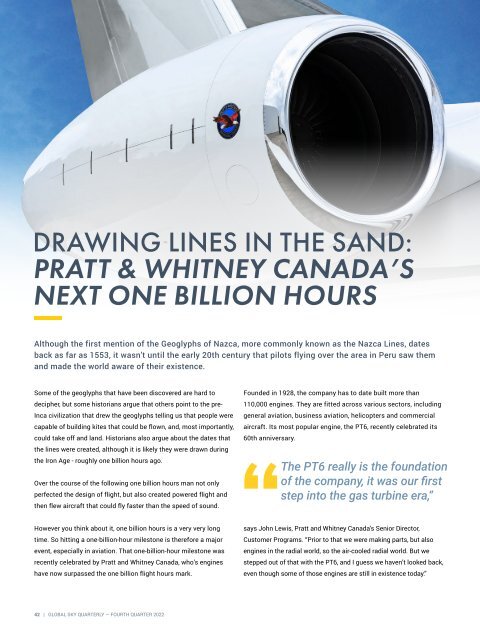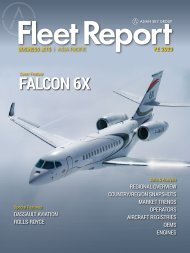Asian Sky Quarterly 2022 Q4
You also want an ePaper? Increase the reach of your titles
YUMPU automatically turns print PDFs into web optimized ePapers that Google loves.
DRAWING LINES IN THE SAND:<br />
PRATT & WHITNEY CANADA’S<br />
NEXT ONE BILLION HOURS<br />
Although the first mention of the Geoglyphs of Nazca, more commonly known as the Nazca Lines, dates<br />
back as far as 1553, it wasn’t until the early 20th century that pilots flying over the area in Peru saw them<br />
and made the world aware of their existence.<br />
Some of the geoglyphs that have been discovered are hard to<br />
decipher, but some historians argue that others point to the pre-<br />
Inca civilization that drew the geoglyphs telling us that people were<br />
capable of building kites that could be flown, and, most importantly,<br />
could take off and land. Historians also argue about the dates that<br />
the lines were created, although it is likely they were drawn during<br />
the Iron Age - roughly one billion hours ago.<br />
Over the course of the following one billion hours man not only<br />
perfected the design of flight, but also created powered flight and<br />
then flew aircraft that could fly faster than the speed of sound.<br />
Founded in 1928, the company has to date built more than<br />
110,000 engines. They are fitted across various sectors, including<br />
general aviation, business aviation, helicopters and commercial<br />
aircraft. Its most popular engine, the PT6, recently celebrated its<br />
60th anniversary.<br />
The PT6 really is the foundation<br />
of the company, it was our first<br />
step into the gas turbine era,”<br />
However you think about it, one billion hours is a very very long<br />
time. So hitting a one-billion-hour milestone is therefore a major<br />
event, especially in aviation. That one-billion-hour milestone was<br />
recently celebrated by Pratt and Whitney Canada, who’s engines<br />
have now surpassed the one billion flight hours mark.<br />
says John Lewis, Pratt and Whitney Canada's Senior Director,<br />
Customer Programs. “Prior to that we were making parts, but also<br />
engines in the radial world, so the air-cooled radial world. But we<br />
stepped out of that with the PT6, and I guess we haven’t looked back,<br />
even though some of those engines are still in existence today.”<br />
42 | GLOBAL SKY QUARTERLY — FOURTH QUARTER <strong>2022</strong>
















